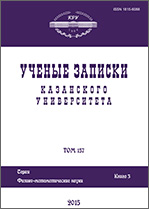|
|
Uchenye Zapiski Kazanskogo Universiteta. Seriya Fiziko-Matematicheskie Nauki, 2018, Volume 160, Book 3, Pages 462–476
(Mi uzku1471)
|
 |
|
 |
A modified formulation of the problem of the steady finger in a Hele–Shaw cell
M. M. Alimov
Kazan Federal University, Kazan, 420008 Russia
Abstract:
The problem of the motion of steady fingers in a Hele–Shaw cell in case of nonzero surface tension was posed more than 60 years ago. However, it has not been completely solved. The analysis in the classical formulation by Saffman and Taylor has revealed that the solution has a singularity at the infinity point where the base of the finger lies. This makes it difficult to realize a correct numerical analysis of the problem. A new modified formulation of the problem is proposed. In this formulation, we postulate that the distance at which the finger is completely formed is limited, which removes the potential source of solution singularity. This distance is, in fact, an additional parameter of the modified formulation. For the case of zero surface tension, it has been established that, in the limit, when this distance tends to infinity, the solution of the problem in the modified formulation tends to the Saffman and Taylor finger solution. Specific examples show that it is sufficient to choose a quantity of order 1 as the value of the additional parameter of the modified formulation. This will already ensure the practical coincidence of the finger shape with the form that corresponds to the classical solution for the case of zero surface tension. It has been also established that the principle of minimum energy dissipation rate formulated in the local form can be used when dissipation is estimated only in a small neighborhood of the free boundary. It has been shown that this principle selects a finger of thickness 0.5 from the family of solutions of the problem in the new formulation in full agreement with the results of the experiments in the case of zero surface tension. The revealed qualities of the modified formulation make it promising from the point of view of its generalization to the case of nonzero surface tension and the possibility of its correct numerical analysis.
Keywords:
Hele–Shaw flow, free boundary problems, exact solution, minimum energy dissipation rate.
Received: 15.02.2018
Citation:
M. M. Alimov, “A modified formulation of the problem of the steady finger in a Hele–Shaw cell”, Uchenye Zapiski Kazanskogo Universiteta. Seriya Fiziko-Matematicheskie Nauki, 160, no. 3, Kazan University, Kazan, 2018, 462–476
Linking options:
https://www.mathnet.ru/eng/uzku1471 https://www.mathnet.ru/eng/uzku/v160/i3/p462
|

|




 Contact us:
Contact us: Terms of Use
Terms of Use
 Registration to the website
Registration to the website Logotypes
Logotypes








 Citation in format
Citation in format 